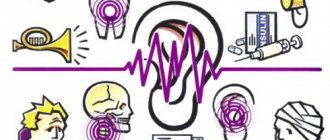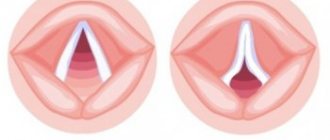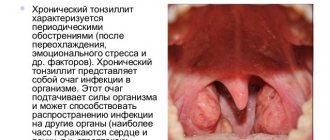Anosmia
Anosmia is a fairly rare pathology that means loss of smell. Hyposmia, a decreased sense of smell, may occur. Anosmia and hyposmia can be congenital or acquired.
Causes
Anosmia is caused by damage to the receptors in the olfactory organs and pathways. The cause of this complication can be numerous diseases. Acute infectious diseases, chronic purulent sinusitis, encephalitis, neuritis of the auditory nerve (especially of infectious etiology), brain tumor, nasal injury, fracture of the ethmoid bone, leading to rupture of the olfactory nerves. In addition, anosmia also appears during poisoning with atropine, morphine, even nicotine. A persistent decrease in the sense of smell - hyposmia is caused by polyps, deviated nasal septum, and tumors.
Hyposmia and anosmia can be caused by completely different reasons and are symptoms of various tissue and organ damage. Therefore, making a correct diagnosis is very important. It is based on conducting numerous thorough clinical studies, since anosmia can be the only external sign of a deadly disease or just a harmless nuisance.
Anosmia in the vast majority of cases is caused by colds, a deviated nasal septum, or polyps. The sense of smell in this case is reduced due to the appearance of a mechanical obstacle in front of aromatic substances on the way to the area of smell.
Neurogenic character in anosmia is extremely rare. It is caused by injury to the frontal part of the head or a tumor of the frontal lobes of the brain, poisoning with chemical reagents. In addition to the loss of smell, the sense of taste is sharply reduced.
Symptoms of anosmia
Persistent decrease in sense of smell.
Diagnostics
Diagnosis, if the cause is unknown, requires a thorough examination for nasal and intracranial diseases and examination of the cranial nerves and upper respiratory tract (especially the nose and nasopharynx). A computed tomography scan with contrast is performed to exclude tumors and fractures of the base of the anterior cranial fossa. A psychophysical assessment of smell and taste identification is also carried out.
Types of disease
Anosmia can be congenital or acquired.
Congenital anosmia occurs as a result of underdevelopment or complete absence of the olfactory pathways and is often combined with other developmental defects. Relatively often, congenital anosmia occurs with congenital deformities of the nose, anomalies of the development of the facial skeleton.
Acquired anosmia can be of two types - central and peripheral origin.
Anosmia can also be of central or peripheral origin.
Anosmia of central origin is a consequence of organic lesions of the central nervous system, including various formations in the brain, disseminated, various circulatory disorders and damage to large arteries due to vascular atherosclerosis or other similar diseases. Central anosmia can occur after meningitis or traumatic brain injury. This type of disease is characterized by the fact that the patient perceives odors, but cannot differentiate them. There is no cure, but the sense of smell can be restored over time if the cause of the smell disorder goes away.
Peripheral anosmia is the only type of smell disorder that can be treated. However, not all of its types are like this. Functional loss of smell, which occurs as a result of influenza, acute respiratory infections, allergic rhinitis, as well as hysteria and neuroses, tends to go away on its own. Senile or age-related anosmia develops due to atrophy of the mucous membrane and excessive dryness in the nose.
Patient Actions
At the slightest suspicion of anosmia, you must consult a doctor and follow the entire range of recommended measures.
Treatment of anosmia
For central anosmia, treatment is limited to treatment of the underlying disease.
With respiratory anosmia, it is necessary to surgically or conservatively remove mechanical obstacles in the nasal cavity that prevent the penetration of air into the olfactory area.
For essential anosmia, drug therapy is indicated.
Prevention of anosmia
Preventive measures boil down to eliminating the cause of loss of smell.
Loss of smell and taste: causes
Central anosmia occurs when areas of the brain are affected. This pathology can be provoked by brain neoplasms (tumors), as well as impaired blood circulation in the brain, which is accompanied by hemorrhages.
Central anosmia can be a symptom of multiple sclerosis, syringobulbia (a rare disease in which cavities filled with fluid form in the brain).
As a rule, pathology manifests itself on the side where the lesion is located.
Essential anosmia occurs as a result of atrophy of the nasal mucosa. The cause of loss of smell in this type of disease can be injury, a chemical burn, or surgery.
A respiratory condition appears when the passage of air through the nasal passages is obstructed. This may be due to the presence of pathologies such as: a deviated nasal septum, polyps, tumors, abnormal enlargement of the nasal turbinates. If the nerve endings are affected, the respiratory form can develop into the essential form.
Functional anosmia is transient and associated with neurotic disorders.
Senile anosmia develops in older people and is associated with atrophy of the nasal mucosa.
Factors that cause problems with the sense of smell also include the following:
- loss of smell with a runny nose (rhinitis), loss of smell with sinusitis and other sinusitis, loss of smell after a cold - that is, all frequently occurring chronic or acute inflammatory processes in the nasal cavity lead to peripheral anosmia;
- injuries and fractures of the nose, skull (especially in the area of the central analyzer);
- tumors developing in the nasal cavity; often a person does not immediately notice the development of anosmia, since neoplasms grow slowly;
- brain diseases: Alzheimer's disease, Parkinson's disease, meningitis and others;
- the use of toxic substances, drugs and illegal drugs, which gradually kill neurons, leading to a violation of the sense of smell;
- smoking - smoke has a detrimental effect on the condition of the nasal mucosa, which leads the smoker to a decrease in sense of smell;
- taking certain medications;
- decreased thyroid function;
- liver and kidney diseases.
Thus, anosmia is caused either by the inability of odors to reach the upper part of the nose due to obstructions in the nasal cavity, or by a problem with the transmission of nerve impulses to the brain. But there are cases when the source of the development of pathology cannot be determined. In this case, they talk about idiopathic anosmia.
Diagnosis of anosmia
To instrumentally confirm the patient’s complaints that he cannot smell, olfactometry is performed - measuring the acuity of smell with a special device - the Zwaardemaker olfactometer. The device is a hollow porous cylinder that contains an aromatic substance and into which a long glass tube with divisions is inserted. During the examination, this tube is gradually lowered into the cylinder - thus dosing the odorous substance entering the nose of the subject. The amount of immersion of the glass tube into the cylinder is expressed in centimeters according to the number of divisions immersed in the cylinder and is a unit of measurement of the acuity of smell - olfactia.
During the examination, a person first determines the appearance of some kind of odor - this value of olfactions is called the threshold of sensation. The tube continues to be lowered into the cylinder, and at a certain moment the subject learns what kind of aroma he is smelling - this is the threshold of recognition, which is always higher than the threshold of sensation that arises earlier. The recognition threshold directly depends on whether a person is familiar with the scent provided to him or not.
With anosmia, the very fact of the absence of smell is determined, but only in some cases can it be determined what its origin is - central or peripheral. As mentioned above, with the loss of the sense of smell of a cerebral nature, the patient can sense the presence of an odor without the possibility of recognizing it; therefore, olfactometry makes it possible to determine a normal or increased threshold of sensation, but the recognition threshold is either sharply increased or not determined at all.
An olfactometric test can also be carried out using all kinds of odors, which includes 40 items of tasks for the patient (for example, identify a specific odor from 4 provided). The reliability of this test is quite high - about 0.95, but it is sensitive to gender and age differences. In patients suffering from complete loss of smell, the test result will be from 7 to 19 out of 40 points.
If a lack of smell is detected in a patient, further research should be aimed at establishing the reasons that caused it. Of greatest importance in this case is a computed tomography of the brain, which makes it possible to detect organic changes in the frontal lobe and other pathologies. If changes in the brain are detected, in order to clarify the diagnosis, further examination and determine treatment tactics, the patient is advised to consult a neurologist and/or neurosurgeon.
What can cause anosmia?
Anosmia can be congenital or acquired. Acquired anosmia may be associated with damage to the nerve pathways as a result of viral diseases (influenza virus, rhinovirus, Epstein-Barr virus, etc.), certain brain lesions, as well as impaired air flow due to rhinitis and other diseases.
Question answer
How will coronavirus be treated at home?
Other causes of anosmia may include a deviated nasal septum, nasal polyps, underdevelopment of the olfactory tract, diseases of the olfactory mucosa and nasal tumors, traumatic brain injury, rupture of the olfactory filaments due to a fracture of the horizontal plate of the ethmoid bone, and destruction of the olfactory bulbs. Complications of sinusitis and intoxication with salts of heavy metals can also lead to this pathology.
Anosmia can develop due to age, smoking, Parkinson's disease and Alzheimer's disease. There are cases when a person does not have any signs of a runny nose, cold or allergy, but he does not smell. In this case, the patient has impaired activity of the channels through which signals are transmitted to the brain.
Treatment with folk remedies
Treating the sense of smell with folk remedies should be treated with caution; if the olfactory nerve is damaged, it will not be possible to restore sensitivity to odors by self-medication. .
Home remedies can restore your sense of smell in cases such as receptor hyposmia, which is caused by impaired access to the olfactory receptors.
Useful for improving your sense of smell:
- rinse the nasal cavity with salt water, sea salt solution;
- purchase an air humidifier;
- add food containing the microelement zinc to the diet - walnuts, sunflower seeds, lentils;
- limit the use of household chemicals with a strong odor in the apartment;
- Do wet cleaning more often and fight dust.
Facial gymnastics
Facial muscle exercises and massage improve blood circulation, which has a positive effect on blood circulation in the nasal cavity:
- Take short breaths for 6 seconds, as if sniffing, then relax your muscles for a few seconds.
- Place your finger on the tip of your nose, then simultaneously press your finger on your nose and press your nose onto your finger, pulling your upper lip down.
- Place your finger on the bridge of your nose, apply pressure, while trying to move your eyebrows.
Each exercise is repeated up to 4 times. You should try not to strain all other facial muscles.
Medicinal plants
Loss of smell due to flu, colds, and runny nose can be cured with basic medication and folk remedies.
Safe, effective ways to restore your sense of smell include the following procedures:
- Dried basil is ground into powder and inhaled.
- Mix corn vegetable oil and olive oil. Twice a day, insert moistened with a mixture of oils into the nostrils.
- Make a mixture of dry peppermint, caraway seeds, chamomile, and marjoram. Grind everything into powder and inhale several times a day.
- Inhale smoke from burning onion, garlic peels, and dry wormwood.
- Chew spicy cloves several times a day, without swallowing.
Folk remedies
Alternative treatment for anosmia must be agreed with your doctor. It is impossible to restore your sense of smell with home remedies alone. However, folk recipes can be used as an addition to the main treatment:
- A solution of sea salt with iodine. This remedy helps clear the nasal passages of toxins, bacteria and pus. 1-6 g of salt should be dissolved in a glass of warm water and add a few drops of iodine. The resulting liquid is used to rinse the nasal passages several times a day.
- A decoction of buckthorn and tansy flowers. You need to take 20 g of each type of plant material and boil it in 250 ml of water. Then leave for 1 hour, strain and cool. The product is consumed 1 glass per day.
- Place 3-4 drops of mint oil into each nostril. You should also rub your forehead and temples with this product.
Causes
Congenital pathology. With this problem, the child experiences symptoms of one or more smell disorders from birth. If the receptors are underdeveloped, Kallmann syndrome (lack of smell) may occur. Moreover, some of the disorders can be inherited from the mother or father.
Various inflammations. Inflammatory processes that occur in the nose area. This most often occurs during a runny nose and is accompanied by a decrease in sensitivity to different odors or a complete absence of smell.
Allergic rhinitis usually causes short-term anosmia. If the allergy is accompanied by allergic polyps, then anosmia can last for a long period of time.
During influenza, the epithelium on which the receptors are located partially dies off - this leads to decreased sensitivity or anosmia. After illness, the sense of smell is restored.
In some cases, when the disease is extremely severe, the sense of smell may be partially restored or not restored at all.
Injury to the inner layers of the epithelium. Injuries can be either mechanical (force applied to the head or nose) or chemical (drugs and substances). People who have suffered a traumatic brain injury often experience a tear or tear in the olfactory nerve, resulting in hyposmia or anosmia for a period of time.
Often the epithelium responsible for the sense of smell is damaged by chemicals and drugs inhaled through the nose. The same thing happens to workers who have to come into contact with harmful toxic substances in factories.
In these cases, there may be a significant decrease in the sense of smell or a complete absence of smell for long periods of time or permanently.
Various formations and tumors. Formations that block the nasal passages lead to temporary loss of smell (until the causes are eliminated).
There are also quite rare types of nasal tumors (esthesioneuroblastoma tumors) that cause hyposmia or anosmia by acting directly on the olfactory receptors.
Metastases from malignant tumors, growth of tumors into the nasal passages and intracranial formations can lead to compression of the bulbs responsible for the sense of smell.
Surgical intervention. Planned operations on the nose and head can lead to a decrease in the sensitivity of the olfactory receptors or to a complete loss of smell for a certain period of time. Most often, the sense of smell is one of the first to be restored during the rehabilitation period.
Other reasons. There are many other reasons that cause a temporary decrease in the sense of smell or its loss. This may be air pollution with various substances and gases, the action and side effects of medications, one of the manifestations of various diseases.
Diseases
A disorder of smell can be a consequence or one of the symptoms of various diseases.
These include:
- Flu.
- Hormonal instability.
- Hypothyroidism, hypogonadism.
- Diabetes and obesity.
- Vitamin deficiency and hypovitaminosis.
- Kidney diseases, incl. renal failure.
- Hypophysectomy.
Quite rarely, a disorder of smell can be found as a consequence of diseases such as cystic fibrosis and Addison's disease.
Causes leading to a disorder of smell that are not associated with changes in the nasal cavity and head:
- Psychogenic disorders and diseases (schizophrenia, depression, stimulation).
- Treatment of concomitant diseases with medications (chloramphenicol, tetracycline, psychotropic substances - amphetamine, thiazides and others).
- Postoperative rehabilitation (especially planned intervention in the nasal cavity).
- Diseases associated with a lack of vitamin A (for example, hepatitis).
- Diseases that change hormonal levels in women.
Causes of anosmia
Having understood the anatomical features of the organs that perceive smells and tastes, you should understand why the sense of smell disappears. Most often, loss of smell is caused by common colds.
Bacteria, viruses, fungi, settling on the nasal mucosa during a cold, cause the development of rhinitis. Resisting infection, the nasal mucosa rejects the inflamed tissue, forming mucus. Together with swelling, mucus prevents the receptors from perceiving incoming information, as a result of which the sense of smell is lost after a cold. Treatment of the underlying disease helps restore the sense of smell and taste during a runny nose.
Although loss of smell is most often caused by a cold, there are many other causes of decreased sense of smell and taste. Anosmia can be caused by the following conditions:
- features of the development of the olfactory pathways;
- inflammatory diseases of the nasal mucosa (rhinitis, sinusitis);
- tumors, nasal polyps;
- traumatic brain injuries;
- brain tumors;
- smoking;
- age-related changes;
- senile dementia;
- Parkinson's and Alzheimer's diseases;
- exposure to toxins.
Preventive measures
Not all causes of anosmia can be controlled and prevented by a person, but to some extent we can reduce the likelihood of pathology occurring. So, the following recommendations will help prevent the occurrence of anosmia:
- do not develop colds and runny nose;
- give up bad habits;
- do not use vasoconstrictor drops for more than 5–7 days;
- use medications strictly as prescribed by your doctor;
- enrich your diet with foods rich in zinc and vitamin A: carrots, apples, ginger, seafood, tomatoes, peas;
- periodically rinse your nose with decoctions of herbs that have an anti-inflammatory effect: chamomile, eucalyptus, sage;
- Follow safety rules.
Considering the seriousness of such a disease as anosmia, one should not forget about all the nuances of its manifestation and begin treatment as early as possible. Don't put off visiting your doctor until later. Do not forget about simple prevention tips, because it is much easier to prevent a disease than to fight it intensively later.
Reasons why the sense of smell is impaired
Temporary or permanent loss of the sense of smell can be caused by diseases of both the structural part of the olfactory system and other organs. There are 4 reasons that disrupt the sense of smell:
- Mechanical blocking of access to receptors;
- Drug abuse;
- Previous or concomitant diseases;
- Congenital anomalies.
A very common cause of hyposmia or anosmia is mechanical blocking of access of odorant molecules to the sensitive receptors of the nasal cavity. This problem occurs when the nasal passages become swollen during a runny nose, an allergic reaction of the body, flu or chronic inflammation of the sinuses. Another common cause of disease is prolonged inhalation of toxic dyes, cigarette smoke, acid fumes, etc.
If the nasal cavity is injured or the nerve fibers associated with the olfactory system are damaged, a person may experience temporary anosmia. When a patient has a tumor in the brain that blocks the path from the receptors to the olfactory center, he will also be unable to distinguish and smell.
After the operation, people may experience temporary anosmia, which goes away after the mucosal tissue is restored. But if the mucous membrane or nerve fibers are damaged due to exposure to radiation therapy, permanent loss of smell may occur.
In children, anosmia or hyposmia may occur due to the use of vasoconstrictor drops in the treatment of rhinitis. Since children are not yet able to explain the state of their health, parents should monitor the period of use of such drugs. Infectious diseases of the respiratory system, eyes, and teeth are a common precursor to anosmia.
Loss of smell occurs due to long-term use of drugs that provoke swelling of the mucous membrane, for example, naphthyzine, reserpine, etc. As soon as slight swelling of the nasal cavity appears, it is better to stop using these drops.
Also, decreased sensitivity to smells occurs after childhood illnesses: mumps, measles. With anatomical changes in the nasal cavity, such as a deviated septum, the growth of polyposis, the presence of adenoids, this also significantly reduces the sense of smell.
Other reasons why the sense of smell is lost can be:
- Diseases (diabetes mellitus, Alzheimer's, Parkinson's, liver cirrhosis, kidney failure, multiple sclerosis, etc.);
- Radioactive exposure;
- Insufficient amount of zinc;
- Plastic surgery of the nose;
- Inflammation of the nerve of the olfactory system due to exposure to toxins or infectious agents.
Less common is congenital anosmia, which is caused by abnormalities in the olfactory system, such as lack of pathways to the olfactory center or underdeveloped nerve canals. These anomalies occur in children who are born with an abnormal structure of the skull and nasal bones. Since anosmia is the most common smell disorder, it is classified according to:
- Duration of the violation (temporary, irreversible, permanent);
- Localization (unilateral, bilateral);
- Distribution (to all odors, to certain aromas).
Characteristics of anosmia
According to the structure of the olfactory analyzer, anosmia can be divided into three main groups.
- Peripheral anosmia - loss of smell is associated with pathology of the sensory apparatus and nose. That is, disturbances in the nasal mucosa and/or receptor apparatus lead to the cessation of perception of odors. This also includes cases of damage to the olfactory bulbs.
- Conductive anosmia is associated with a disturbance in the transmission of nerve impulses anywhere from the bulbs to the subcortical centers.
- Central anosmia. Lack of smell occurs as a result of a disruption in the processing of nerve impulses from receptors.
Based on the time of onset, anosmia is divided into congenital and acquired. The reasons for the first lie in violations of the olfactory analyzer that occurred at the stage of intrauterine development. Acquired pathology can appear at any age of independent life due to various diseases and pathological conditions.
In connection with all of the above, the main causes of anosmia become clear. These include the following:
- Congenital anomalies of the development of the nasal mucosa or the nasal passages themselves. This includes almost all cases of congenital anosmia.
- Diseases of the nasal cavity. Most often, such nosologies are acute and chronic rhinitis, sinusitis and nasal polyps. They lead to the development of a peripheral variant of loss of smell.
- Injuries to the nose and skull. These reasons lead to the occurrence of peripheral, conduction and central acquired anosmia. Peripheral disappearance occurs due to the destruction of receptors and olfactory bulbs due to bone trauma. Conductive - as a result of damage to nerve fibers. And they are injured by fragments of skull bones. Among them, loss of smell is most often caused by fractures of the ethmoid, occipital and temporal bones. Naturally, in this case, treating anosmia with folk remedies will not give any effect.
- Benign and malignant neoplasms of the nose and brain. Can cause any of three types of loss of smell. It is noteworthy that, unlike injuries, anosmia develops quite slowly and sometimes the patient cannot notice it.
- Inflammatory and non-inflammatory diseases of the brain. They most often lead to central loss of smell due to damage to cortical neurons. These include the following nosologies: encephalitis, meningoencephalitis, multiple sclerosis, Alzheimer's disease.
- Intoxication. For example, cadmium, benzene, and some organic ethers tend to accumulate in brain neurons, which can lead to their death.
- Smoking. As an independent factor, it can cause peripheral anosmia due to damage to the mucosa. The same can be said about cocaine.
Treatment
Treatment of anosmia is almost impossible, but it is enough to eliminate the causes that caused this disease, and the symptoms of anosmia will go away. That is why treatment can be applied to different types of peripheral lack of smell. In order to prescribe adequate and correct treatment, it is necessary to accurately determine the cause of the disease. The doctor identifies the symptoms and, most often, prescribes a brain scan and recommends a consultation with a neurologist.
Treatment for the functional form is usually not required; the problem goes away on its own. Eliminating the causes of problems with the patency of the nasal passages will help get rid of respiratory anosmia. Atrophic changes in the mucous membrane, unfortunately, cannot be cured. If there are symptoms of anosmia of central origin, you need to look for the reasons in the central nervous system disorders that caused this condition.
Folk remedies
In folk medicine there are simple and accessible remedies for eliminating curable forms of anosmia. Along with taking medications, folk remedies will complement the course of treatment and will also help you quickly return to normal life.
- A useful exercise would be the following: tense the nose, then relax. You need to hold on in a tense state for at least 50 seconds. The exercise should be repeated throughout the week.
Inhalations help well with anosmia
- Boil 200 ml of water in an enamel container, pour in 1 tablespoon of lemon juice, add 1 drop of lavender essential oil. Breathe deeply over the resulting mixture, covering each nostril in turn. It is advisable to carry out at least 10 such procedures.
- It is recommended to rinse your nose with salt water. To do this, take 250 ml of warm water, dilute a pinch of salt in it, and stir. Covering either nostril with your finger, you need to try to draw in water through the second nostril so that it goes all the way to the larynx. For the same procedures, it is permissible to use other means - water diluted with salt or sea water. For a glass of water you will need 1 teaspoon of salt and 7-8 drops of iodine.
- You can put 3-4 drops of menthol oil into your nose, lubricating both your nose and temples with it.
- Propolis also has a good healing effect. You will need 1 teaspoon of propolis, 3 teaspoons of vegetable oil and 3 teaspoons of butter. Mix all ingredients well to obtain a homogeneous mass. Soak gauze or cotton swabs in it. These swabs should be applied to the nostrils and left for 20 minutes. This treatment is carried out 2 times a day.
Treatment of anosmia
It is important! When deciding how to treat anosmia, it is necessary to determine its causes. Thus, congenital and acquired pathologies of smell require therapy as different as anosmia caused by traumatic brain injury and cocaine use.
Treatment of congenital impairment of smell is difficult due to the fact that neurons are practically incapable of regeneration. Even successful reconstructive surgeries to eliminate developmental anomalies of the facial part of the skull provide partial restoration of the sense of smell in less than 0.1% of cases. And only with surgery up to 3-4 years. And, as you know, surgical interventions on the face of children to restore anomalies are performed extremely rarely. One of the main reasons is the ongoing development of their skull.
Acquired peripheral and conduction anosmia, first of all, requires correction of the underlying disorders. For example, loss of smell due to rhinitis and sinusitis, at the first stage, includes treatment of underlying pathologies. Therapy for anosmia may not be required, since in these cases, the sense of smell is gradually restored on its own.
Loss of smell as a result of injuries to the nose and face may also not require treatment. After repairing the damage, sensitivity to odors. However, in the case of complete intersection of the pathways, restoration of the sense of smell is impossible.
Finally, central anosmia depends entirely on the success of treatment of the underlying disease. And the use of local substances is absolutely useless.
It is important! Thus, treatment of anosmia with folk remedies and using traditional methods directly depends on the underlying disease. At the same time, the degree of restoration of the sense of smell is more possible with the peripheral type than with the central type.
Rate this article:
(votes: 1 , average: 5.00 out of 5)
Loading...
Related posts:
Diagnostics
The diagnostic program will depend on the current clinical picture. The initial examination can take place with the participation of the following highly qualified doctors:
- neurologist;
- neurosurgeon;
- otolaryngologist.
First of all, a physical examination of the patient is carried out, with the collection of personal and family history and the current clinical picture.
To determine the nature of this clinical manifestation, the following laboratory and instrumental examination methods can be used:
- clinical and biochemical blood test;
- general urine analysis;
- CT, MRI of the brain;
- olfactometry;
- tumor marker test;
- biopsy of the tumor for histological examination.
Based on the results of the study, the doctor can establish an accurate diagnosis and determine further therapeutic measures to eliminate the underlying disease.
Olfactory disorders classification
There are 4 forms of olfactory hyper-or dysfunction:
- Hyposmia;
- Anosmia;
- Hyperosmia;
- Dysosmia.
With hyposmia, a person only slightly loses their sense of smell or has a reduced sense of smell. This problem is quite common and does not allow you to fully enjoy life.
But with anosmia, the sense of smell is completely lost, which leads to behavioral disorders. For example, the lack of smell prevents you from enjoying food because it becomes tasteless. It would seem that the sense of smell cannot in any way influence the taste of food, but no. If a person does not smell the food, he is not interested in consuming it. Accordingly, this forces him to refuse food, causes exhaustion, lack of vitamins and even psychological illness such as depression.
Also, the loss of smell becomes a serious threat to a person’s life, since he will not be able to smell the dangerous odors of smoke or toxic substances.
Hyperosmia, on the contrary, makes a person’s nose very sensitive to various odors. If the sense of smell is impaired, patients suffer from irritability, they may even have hallucinations with disgusting odors that are not there. Typically, this disorder occurs in patients with gastrointestinal problems, for example, who often experience nausea. Hyperosmia also appears during fasting or obesity. With or, as it is otherwise called, cacosmia, a violation of the sense of smell consists of a distortion of odors. This disease occurs in the presence of tumors in the nasal cavity, which pass through the area where the olfactory receptors are located or along the entire chain of nerve canals. Dysosmia causes a person to smell odors that do not exist or to convert fragrant odors into disgusting ones.
Most often, people experience anosmia and hyposmia; other disorders appear very rarely. Research in the United States shows that smell impairment affects 1.4% of people in the country. Anosmia reduces the quality of life of 5% of the German population. Such studies have not been conducted in Russia, but it is obvious that these indicators will be similar.
Diagnosis of smell disorders
To understand what type of anosmia it is, you need to identify the causes of its occurrence. Today, the leading causes of olfactory dysfunction are occupied by traumatic brain injuries (children and young people) and viral diseases (older patients).
It should be noted
According to statistics, a decrease or complete loss of smell occurs with every tenth traumatic brain injury. Injuries to the frontal and occipital parts of the skull are especially dangerous.
Post-traumatic disorders are less responsive to treatment than others. The sense of smell is partially or completely restored in only 10% of patients. In this case, the perception of odors may be distorted.
With viral anosmia, the sensitive epithelium is destroyed by the virus and is subsequently replaced by the respiratory epithelium.
Among the tumors that cause anosmia, Meningioma is the leading one.
Also, with pathology, olfactory hallucinations may occur. In this case, a person thinks that he smells a smell that others cannot sense.
This is typical both for anosmia caused by tumors and for olfactory disorders due to alcohol abuse. Olfactory hallucinations can also be based on mental illnesses - schizophrenia and depression.
Classification and causes of loss of smell
During the flowering period of plants, allergic rhinitis can cause a decrease in the sense of smell.
Both the loss of smell (or anosmia) and its decrease (or hyposmia) can be congenital or acquired.
Congenital lack of smell is a consequence of the complete absence of the respiratory tract or their partial underdevelopment. Often this pathology accompanies congenital anomalies of the nose or facial skull.
Acquired loss of smell can be of peripheral and central origin: peripheral occurs when the disorder is localized in the area of the nose itself, and central occurs when there is organic damage to the central nervous system.
Peripheral anosmia, in turn, depending on the reasons that caused it, is divided into 4 types:
- functional (is a manifestation of viral infections, allergic rhinitis - in this case it is a consequence of swelling of the nasal mucosa; can occur with neuroses and hysteria; after eliminating the cause of anosmia, the sense of smell is fully restored);
- respiratory (develops when air containing molecules of aromatic substances passes through the nasal passages, but for some reason cannot reach the peripheral part of the olfactory analyzer; often these causes are deviated nasal septum, hypertrophy of the nasal turbinates, adenoids, polyps and other benign and malignant tumors of the nasal cavity);
- senile, or age-related (the result of atrophic changes in the nasal mucosa, in particular the mucous epithelium, which leads to dryness of the nasal mucosa);
- essential (the result of damage to the immediate peripheral part of the olfactory analyzer, which arose in connection with the inflammatory process in this area, burns of the nasopharynx of any nature, household or surgical trauma to the nose/nasopharynx area, hypo- or atrophy of the olfactory epithelium, prolonged compression of the olfactory cavity by any tumor process , as well as toxic damage to it).
Peripheral anosmia in most cases is characterized by a decrease in taste sensations in parallel with a deterioration in the sense of smell.
A decrease in the sense of smell of central origin, or cerebral anosmia, can occur with the following diseases:
- acute or chronic cerebrovascular accident of atherosclerotic or other nature;
- brain tumors in the anterior cranial fossa (meningioma, frontal lobe glioma);
- disseminated encephalomyelitis;
- traumatic brain injury of any severity;
- arachnoiditis;
- meningitis;
- inflammation of the ethmoid sinus;
- Alzheimer's disease.
With cerebral anosmia, if the pathological process is localized in the area of the cortical centers of smell, a person determines the presence of an odor, but cannot verify or determine its type.
2. Reasons
Possible causes of anosmia are many and varied. In some cases, it is generally congenital in nature, being an element of chromosomal syndromes, for example, Siewert-Kartagener syndrome, Kallmann syndrome, etc.
Another large group of etiological factors are infections of the ENT organs, especially the upper respiratory tract: ARVI, complicated sinusitis, chronic nasopharyngitis, etc.
Often the causes of anosmia/hyposmia are predominantly mechanical in nature: the path of penetration of aromatic vapors or suspensions to the olfactory receptors is blocked, often partially. This situation occurs with severe deformation of the nasal septum, as well as with various hyperplastic, hypertrophic, neoplastic processes, both benign and malignant.
Causes associated with damage to the central and peripheral nervous system include meningoencephalitis, brain tumors, neuritis, damage to conductive nerves due to maxillofacial injuries and fractures (usually ethmoid bone fractures), cerebrovascular disorders, etc. Central anosmia also includes transient blackouts sense of smell in disorders of the hysterical circle.
Anosmia may be associated with degenerative changes (with chronic atrophic rhinitis, natural aging, Alzheimer's disease, Parkinson's disease, etc.) in the mucous membranes of the nose or the olfactory structures of the telencephalon.
In addition, transient or irreversible loss of smell can develop under the influence of toxic compounds, depending on the concentration of the latter and the duration of contact with them (morphine, nicotine, cocaine, atropine alkaloids, acrylates, etc.).
Finally, in some cases, anosmia is recognized as idiopathic, since the current level of development of diagnostic tools does not allow linking the loss of olfactory function with any etiopathogenetic factors.
Visit our Otolaryngology (ENT) page
Why do people smell?
Before you begin to become familiar with olfactory dysfunctions, you need to know the structure of the olfactory system. Then it will be easier to understand the reasons why a person may lose his sense of smell or react too strongly to any odors.
The olfactory system includes four structures that form a single unbroken chain:
- Receptors;
- Nerves;
- Bulbs;
- Cortical nerve center.
The first structure is receptors. Cells with high sensitivity are located on the mucous membrane in the upper part of the nasal cavity. Due to the fact that the receptors are located close to the brain, the processes of these cells freely penetrate into the cranial cavity. As soon as a person inhales any substance with a strong or weak odor, its molecules pass through the olfactory region of the receptors and irritate them.
The second structure, that is, the nerves, immediately transmits the received information about the odorous substance to a specific part of the brain.
The third structure - the bulbs - collaborates with the subcortical and cortical olfactory center, where odor analysis and decoding is carried out.
The amazing thing is that our nose can distinguish approximately 10 thousand original aromas. But what is even more surprising is that the brain is able to remember these individual odors as soon as it analyzes and deciphers them for the first time. Using the sense of smell, you can recognize that there is vanillin in the room, although its concentration in 1 liter of air is only 1:100 billion fractions of a gram.
Sensitive olfactory receptors are located in the upper part of the nasal passages and occupy about 5 cm2, that is, 2.5 cm2 in each passage. They are also located in a small hole, which is located 1.5-2 cm from the edge of the nostrils. Despite the fact that the area of sensitive cells is tiny, it is amazing in its ability to distinguish such a huge number of odors. It has been scientifically proven that women are more sensitive to odors than men. Their sense of smell is not only sharper, but also lasts much longer - until old age. And during pregnancy or during ovulation, the olfactory center becomes even more sensitive. But at the beginning of the menstrual cycle, women who do not take contraceptives with hormonal components experience a temporary decrease in their sense of smell. With age, sensitivity to odors gradually becomes dull due to atrophy of the olfactory nerve fibers.
As already mentioned, all four structures form a single chain, therefore, if one of the links of the olfactory system is disrupted, a disorder in the sense of smell occurs. Specialists can determine the type of disorder and prescribe treatment after they find out which part of the olfactory structure has been damaged.
Brief anatomy and physiology of smell
Smell is one of the five basic senses of humans and animals. And just like the others, several anatomical structures take part in its formation.
Olfactory receptors. They are the first link. They are located on the mucous membrane of the nasal passages. The mechanism of odor perception is the contact of substance molecules with the receptor membrane. It occurs due to the presence of a special mucous secretion on their surface, which, as it were, “sticks” the molecules to the epithelium. Without it, contact would require several thousand times more molecules of the substance, and a person’s sense of smell would be 0.001% of the present. In many ways, the treatment of anosmia with folk remedies is aimed at the nasal mucosa and these receptors.
- Olfactory bulbs. This is a collection of neurons on the inner surface of the nasal bones. Olfactory receptors are processes of nerve cells that make up the bulbs. Each nerve cell has two processes. One goes to the nasal mucosa, where it ends with a receptor, and the second, as part of the olfactory nerve, goes to the olfactory zones of the brain.
- Central analyzer. It represents the same areas of the brain. It includes: subcortical structures (mainly the limbic system) and neurons of the olfactory zone of the cerebral cortex. Moreover, there are two of them: one in each hemisphere. Numerous studies have shown that these zones are located at the base of the cerebral hemispheres and border the taste analyzer.
- The formation of the sense of smell occurs as follows. When inhaled, the molecules of the odorous substance adhere (stick) to the olfactory epithelium. After this, they come into contact with the membranes of the receptors, causing them to produce an impulse. It enters the olfactory bulbs, and from there into the cortical olfactory areas of the brain. Here it is processed and the sense of smell is formed.
It is important! It should be noted that the cortical analyzer is closely connected with analyzers of other senses, and is located on the border of the temporal lobes with the brain stem. This makes the sense of smell an integral part of human emotions. Therefore, the loss of this feeling significantly impoverishes the emotional background and makes the treatment of anosmia an equally important aspect of social adaptation.











